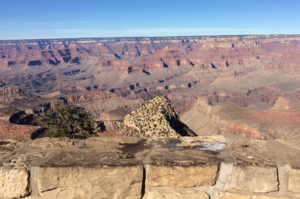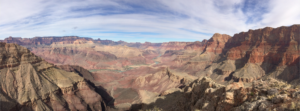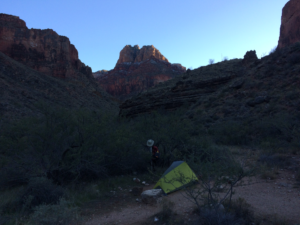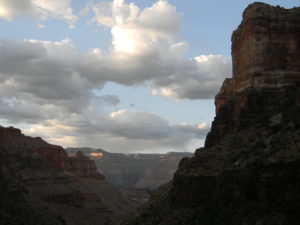Why did Grand Canyon become a National Park?
The answer to this question seems obvious. Simply put, it is the Grandest Canyon on the planet. Scenery aside, Grand Canyon is a treasure trove of resources that scream for preservation. To truly answer the question though, we must delve into why any National Park exists. It’s not just the scenery that makes Grand Canyon famous, but the pioneers that preserved it. The story of Grand Canyon’s journey to National Park status is as deep and wide as the canyon itself. Henceforth, come as The Goat tells the tale of the how the National Parks, and Grand Canyon itself, came to be.
Why are there ANY National Parks?
A National Park is an area that has been set aside for preservation and public use by an act of the President or Congress. Most importantly, it is closed to industry and private development. However, the story of the National Parks begins, as many stories in the development of the Western United States. Pioneers, prospectors, and the railroad were the driving force.
The purchase of land by the US Government in the early 1800’s opened the land. In these wide-open spaces, places were discovered unlike any on Earth. Soaring mountains, deep canyons, active volcanoes, and extraordinary landscapes were the norm. The discovery of gold in California sparked a massive westward expansion in 1849, and flooded the wild lands with pioneers and opportunists. Many of those that didn’t strike it rich realized the potential for preservation of these beautiful places.
Political Movement and Conservation
In the 1870’s, a political movement known as “democratic liberalism” had washed over the nation. Americans were concerned with the perceived ravages of unchecked capitalism, and Congress responded. The Congress enacted the Forest Service Act, one of many new laws passed aimed at social reform. The new law allowed the Federal Government to set aside areas like Yellowstone, Yosemite, and Sequoia National Forest for protection.
Yellowstone became the first National Park in 1872, and the party had just begun. Using the Forest Service Act, the Yellowstone National Park Act was cemented into law in March of that year, and kicked off a generation of conservation that created many of our most famous National Parks.
The First National Parks
Yellowstone was, of course, the first National Park created in 1872. However, many other parks came before Grand Canyon. Sequoia was set aside for protection in 1890, along with Yosemite. Grand Canyon National Park was created in 1919, but by then, Rocky Mountain, Crater Lake, and Hawaii Volcanoes among others had already been established.
The Antiquities Act
In 1906, Congress created the Antiquities Act. The act gave the President power to establish National Monuments, by using land already owned by the Federal Government. It paved the way for the creation of the National Park Service in 1916, and the NPS now manages 61 National Parks, and many more National Monuments.

Grand Canyon Becomes a National Park
The cultural history of Grand Canyon dates back several millennia, but the first Europeans to arrive in the Grand Canyon region came after the Mexican-American War of the 1840’s. Trade and transportation routes opened up in the American Southwest and began to approach the North and South Rims of Grand Canyon.
The story of Grand Canyon becoming a National Park begins, as many stories in the settlement and development of the Western United States, with pioneers, prospectors, and the railroad. Grand Canyon was an unknown wilderness for the first five million years of its existence, but that was about to change.
Early Pioneers and Exploration
Early Pioneers in the area included Bill Bass and Ralph Cameron. Louis Boucher, better known as “The Hermit”, built a wonderful trail into the canyon’s depths. John Wesley Powell, “The Father of the American Southwest”, was the first to navigate the Colorado River from Lee’s Ferry to Pearce Ferry in 1869. His book, The Exploration of the Colorado River and its Canyons, documents the journey.
Powell’s voyage was important in mapping Grand Canyon. It was was the key to unlocking the unknown. There was little known about the inner canyon before. Powell took 11 men on the expedition, and 8 finished the journey. One man became ill, and another injured himself. Two men gave up, and climbed out of the canyon near Toroweap. They were never seen again, and it is unknown what happened to them.
Powell was the head of the US Geological Survey at the time. His expedition opened the canyon for more intensive geologic research, and scientists from around the world came to study the canyon. The rocks in Grand Canyon hold many secrets. Two billion years of Earth’s history is contained in its walls. Above all, Grand Canyon is a window into time.
Mining and The Railroad Come to Grand Canyon
The Union and Pacific Railroad arrived in the 1870’s, and along with the Santa Fe Railroad began to provide transportation to and from Grand Canyon for tourism and industry. Several mining claims were established in the canyon, most notably the Last Chance mine below Horseshoe Mesa. Last Chance was one of the only mines that was profitable. The profits, however, were short-lived.
Most prospectors in Grand Canyon quickly realized that they could make far more money with tourism, and improved routes down into the canyon. Mules and horses carried tourists and their trappings down into the canyon, where a camp awaited. After that, tourism grew quickly, and soon the railroad companies became interested.
The first train to arrive at Grand Canyon’s South Rim pulled up in 1901. El Tovar Hotel was completed in 1904, and was immediately heralded as the finest accommodation in the west. The railroad stop literally paved the way for the development and growth of the burgeoning park, and people flocked to take in the views.

Grand Canyon Becomes Protected Land
First, Grand Canyon was protected under the Forest Act in 1882, to the chagrin of many would-be industrialists. Then, President Theodore Roosevelt used the Antiquities Act to establish Grand Canyon National Monument in 1908. The newly created power protected the canyon from any and all private claims. Finally, Senator Henry Ashurst of Arizona introduced the bill that officially made the Grand Canyon a National Park in 1919. It is now one of the most popular places on Earth.
Grand Canyon has seen tens of millions of visitors since its designation. In 2018, visitation hit an all-time high at over 6.4 million, and it is the 8th-most visited Park in the system. National Parks such as Golden Gate Bridge and the Lincoln Memorial are also designated National Parks, and places such as these the most total visitation. After that, Grand Canyon sits behind only Great Smoky Mountains in terms of the natural National Parks.
Going Guided
Hiking and exploring Grand Canyon, or any of the National Parks, is a special experience. Although it is possible to see these places yourself, hiring a guide is a great idea. For instance, guiding services provide logistical support, and plan everything for your best possible trip. They provide a great safety net on the trail, and are trained in backcountry medicine. Above all, they provide a depth of knowledge of the region that turns a walk into a true adventure.
Blue Marble Adventure GeoTourism provides all of the support you need, and pairs that with expert geologist/guides. Our backcountry meals use fresh ingredients, and are planned by a professional chef. Furthermore, we provide top-of-the-line gear and passion for the places we explore. In conclusion, you can visit National Parks, but going with a guide can create and even more memorable experience. Don’t be shy, and call us!

The Goat’s Final Word
As you can see, the real answer of how Grand Canyon became a National Park is not so obvious. The question why is an obvious answer, but how is the real answer. The scenery and beauty at Grand Canyon are magnificent. In other words, the clear need to preserve this special place is made obvious the moment you approach the rim. However, it took gumption and years of political action that brought us the National Parks. Therefore, visit the National Parks. They are magical places. Marvel in the surroundings, and appreciate how they came to be.
Why did Grand Canyon become a National Park? The answer is simple. How though? Fortitude. Commitment. Perseverance. Dedication to a cause. The actions of a relentless band of rebels. The same actions and fortitude that carved the entire National Park system. In conclusion, action.
Read our blog!
For adventure hiking vacations in a geologic time machine, see our epic tours in Grand Canyon, Utah, and Arizona!
For geological musings read The Goat’s geology blog.
Follow us on Facebook and Instagram

